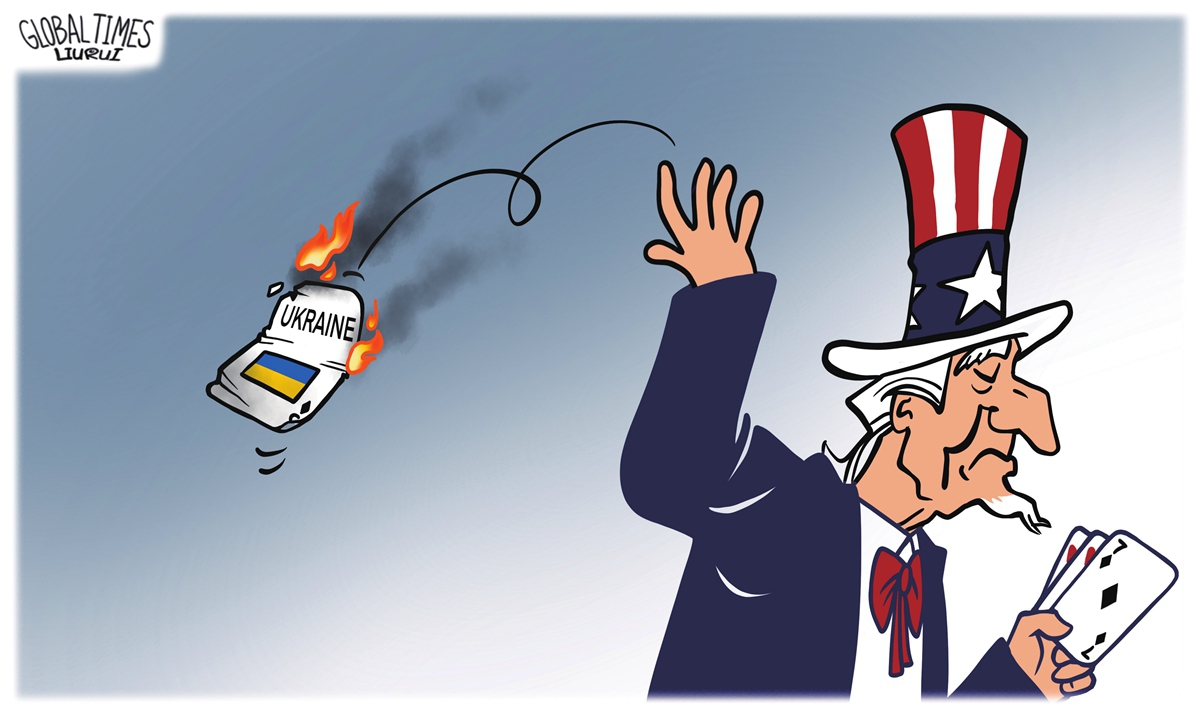
Illustration: Liu Rui/GT
German Chancellor Olaf Scholz is set to visit the US to meet with President Joe Biden on February 9, during which time they're expected to focus much more on Russia than on Ukraine. While casual observers might think that these two subjects are basically the same for all intents and purposes, Western support for Ukraine is only part of the bloc's quest to contain Russia. Supporting Ukraine is much more than simply sending arms and funds to Kiev. Notably, the West is supplying less arms and funds to the country than before.
The Russian Defense Ministry estimated in early January that Western aid for Ukraine had by that time surpassed $200 billion, which was provided by over 50 countries. According to them, more than 500 commercial and military satellites are being used in one way or another against Russia. Other data points include "more than 1,600 units of missile and artillery equipment, over 200 air defense systems, some 5,220 tanks and armored vehicles, and more than 23,000 drones."
The failure of Ukraine's NATO-backed counteroffensive last summer led to a reduction in military and financial assistance to the former Soviet Republic. The EU recently overcame internal divisions to approve €50 billion in funding over the next four years. That money will go toward meeting its administrative needs in order to avert the state's collapse and not toward new arms purchases, though some might still be siphoned off for that purpose.
Since the abovementioned military debacle, two important initiatives have been undertaken to continue arming Ukraine despite growing fatigue among the Western public and some policymakers. Germany, which is already the second-largest contributor, just approved this year's budget that will provide another €7.6 billion in military assistance. The US, meanwhile, reportedly devised a creative scheme whereby it will arm Greece so that Greece can then arm Ukraine with its older weapons.
These new forms of financial and military aid are still a lot less than what had previously been provided thus far in total, however, and they also came after a delay lasting several months. Therefore, nobody should expect Ukraine to launch another counteroffensive anytime this year, which aligns with the Washington Post's report last month that "US war plans for Ukraine don't foresee retaking lost territory". American, German and other Western aid will accordingly focus on defense from now on.
It's within this context that Scholz will soon meet Biden, and while they will predictably discuss the Ukrainian conflict, they'll likely spend much more time talking about how to jointly contain Russia in ways that go beyond the battlefield and last much longer than NATO's proxy war it. Observers should remember that NATO is carrying out its largest military drills since the Cold War, "Steadfast Defender 2024", which involve over 90,000 troops and hundreds of aerial, ground and naval assets until June.
In terms of shaping the long-time dynamics of their rivalry with Russia, these moves that Ukraine's top two funders are making on the continent right now are much more important than sending more aid to Ukraine.
After all, the over $200 billion that's been provided thus far failed to ensure the success of summer's counteroffensive, so whatever else might be provided in the future - whether unilaterally or jointly - won't realistically reverse the conflict's latest dynamics that put Kiev back on the defensive. Remembering the Washington Post's report from last month, any forthcoming aid will only serve to help Ukraine hold onto the territory that it already controls, not retake that which it has already lost.
Considering this, no game-changing aid package is expected to be announced during the upcoming US-German Summit, even though some symbolic pledges can't be ruled out for the sake of upholding Western morale and reinforcing perceptions of trans-Atlantic unity in this conflict. The pace, scale and scope of Western aid to Ukraine is unlikely to return to its pre-counteroffensive levels. Instead it will probably remain limited though more focused on tangibly enhancing Ukraine's defensive capabilities.
This could perpetuate the stalemate that Commander-in-Chief Valery Zaluzhny candidly admitted in his interview with The Economist last fall had begun to characterize the conflict if it's successful. In that event, the best-case scenario would be for the West to encourage Ukraine to resume peace talks with Russia aimed at satisfying the latter's security interests that were responsible for its special operation in the first place. Regrettably, however, so far there hasn't been any interest in such talks.
The resumption of peace talks probably won't be on the horizon for some time. The resumption of large-scale financial and military aid for Ukraine isn't foreseeable either, as was explained in this analysis, with these two factors combining to perpetuate the present stalemate.
Under these circumstances, it's much more likely that joint US-German long-term strategic cooperation aimed at containing Russia - such as via the partially formed "military Schengen" - will occupy the lion's share of their leaders' talks, not the subject of more financial and military support for Ukraine. Unless there is a Russian breakthrough, which can't be ruled out nor taken for granted, the conflict will probably remain a stalemated since the West isn't interested in peace talks even though now is the best time for them.
The author is a Moscow-based American political analyst. opinion@globaltimes.com.cn




